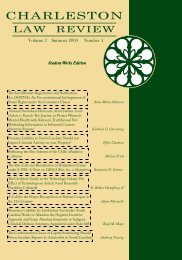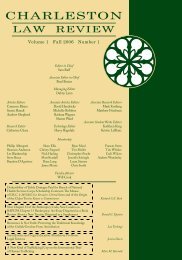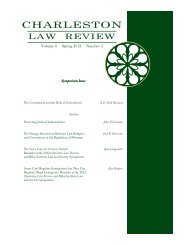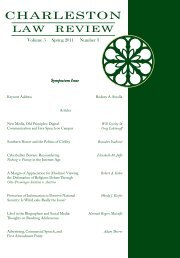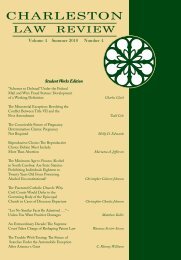Volume 5 Winter 2011 Number 2 - Charleston Law Review
Volume 5 Winter 2011 Number 2 - Charleston Law Review
Volume 5 Winter 2011 Number 2 - Charleston Law Review
Create successful ePaper yourself
Turn your PDF publications into a flip-book with our unique Google optimized e-Paper software.
SCHULZE FINAL.doc1/20/<strong>2011</strong> 6:14PMCHARLESTON LAW REVIEW [<strong>Volume</strong> 5environment basically is an object-lesson in how not to provideautonomy support. There is little, if any, choice provision in thefirst year: 234 students may not select their courses; they arepresented with one method to learn the law—read cases, readhornbooks, write outlines; and they are even taught that there isjust one way to think about law. Possibly of more importance,the second aspect of autonomy support is absent: Studentsusually never learn why there is no choice provision. If studentswere given an explanation as to why classes are all mandatory—because the bar exam focuses on these subjects and they are theuniversally foundational subjects—at least that would providesome autonomy. Instead, students are expected to do as they aretold, even if it means studying five subjects in which they havelittle interest. Finally, in the traditional law school environment,students often lack any indication that authority figures (faculty)care about their points of view.Once again, ASPs go a long way in ameliorating thissituation. In terms of choice provision and the traditional lawschool implicitly telling students that there is just one way tolearn the law, ASPs provide students with a deeperunderstanding of alternative ways to learn the law. As discussedpreviously, ASPs’ focus on learning styles theory provides choicesto students in terms of how they learn law: 235 visual, auditory,read-write, and kinesthetic learners can all tweak their studyprocedures to work with, rather than against, the way that theirbrains process information.Some ASPs take this a step further by providing instructionto students not only on how best to work with their individuallearning styles, but also how to determine and study inaccordance with their personality typology. 236 The essence ofpersonality typology, perhaps best typified by the work of C. G.Jung, Katherine Briggs, and Isabel Briggs Myers, is that “muchseemingly random variation in . . . behavior is actually quiteorderly and consistent, being due to basic differences in the ways234. Lustbader, supra note 32, at 618–19.235. See supra notes 188–99 and accompanying text.236. See Telephone Interview with Martha Peters, Professor of Legal Educ.,Elon Univ. Sch. of <strong>Law</strong> (June 29, 2010) (on file with author).324



